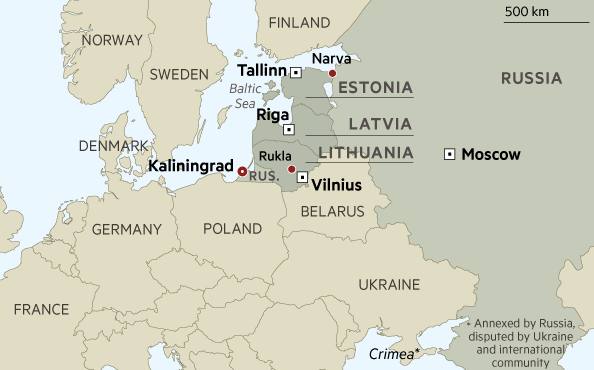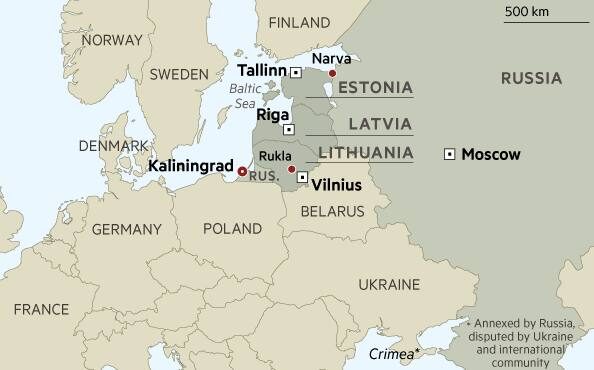
PEJOURNAL – That German warplanes are within immediate range of Russia’s Kaliningrad oblast (and not much further from St. Petersburg, formerly Leningrad) and that Germany is in charge of a permanent battlegroup formation in Lithuania are topical issues as we approach the eightieth anniversary of Germany’s Operation Barbarossa invasion of Soviet Russia in 1941.
When the Baltic states and former Soviet republics Estonia, Latvia and Lithuania were brought into NATO in 2004, five years after Baltic neighbor Poland, that expansion consolidated the process of turning the Baltic Sea into a NATO one. The above four nations joined NATO members Denmark and Germany and de facto members Finland and Sweden in isolating the only non-NATO member or candidate bordering the sea: Russia. The latter only has access to the Baltic Sea through its Kaliningrad exclave, which has been and willing increasing be challenged by NATO and its local members. Kaliningrad and Belarus are the only buffers separating Russia proper from ever-encroaching NATO forces on its northwestern border.
A comparable goal was also achieved in 2004 in the Black Sea with the incorporation of Bulgaria and Romania into the military bloc; with Turkey already a member and Georgia and Ukraine NATO partners (both were granted Annual National Programs shortly after the five-war between Georgia and Russia in the Black Sea region in 2008), that left Russia isolated in the Black Sea as well as in the Baltic Sea. Russia for centuries has maintained its Black Sea Fleet in Sevastopol, in Crimea. Moscow would have been justified in anticipating that fleet’s eviction after the 2014 U.S.-engineered violent coup in Ukraine had it not taken measures to protect it.
If Iran could be neutralized, the US and NATO would attempt to accomplish the same goal in the Caspian Sea, as Azerbaijan, Kazakhstan and Turkmenistan are NATO partners.
Turning the Baltic, Black and Caspian Seas into exclusive US and NATO spheres of influence and military strongholds would effectively sound the death knell for Russia as a sovereign nation.
Despite COVID-19 restrictions, NATO has been busy consolidating its military presence in the Baltic region this month. The alliance recently reported that Allied and Partner Air Forces (its nomenclature) completed three days of Baltic Trident exercises which included the participation of US F-15 fighter jets (video) and KC-135 Stratotankers flown from bases in Britain, Lakenheath and Mildenhall, respectively. They flew to the Ämari Air Base in Estonia for the drills. The American aircraft flew combined missions with warplanes from NATO allies Britain, Estonia, Lithuania and Poland and de facto NATO member Finland. (See above.) The Estonian air base is also currently hosting a German Air Force Eurofighter detachment, part of NATO’s Baltic Air Policing mission.
What NATO euphemistically (and evasively) calls Baltic Air Policing is in fact the permanent rotation of fighter jets from member states that began almost immediately after Estonia, Latvia and Lithuania were absorbed into NATO. It’s important to note that this was initiated four and a half years before the Georgian-Russian war over South Ossetia and a full decade before Donetsk and Lugansk seceded from Ukraine and Crimea was reunited with Russia, as NATO and its advocates have tried to create the impression that the first occurred as a result of the second.
The NATO warplanes, deployed for three-month rotations, began operating out of the Lithuanian Air Force Base near Šiauliai. In 2013 the Baltic Air Policing fighter jets in Lithuania at the time were activated when Sweden (see above) claimed not to be able to respond to a “simulated attack by Russian bombers against Stockholm.” (The words in quotation marks are from the Atlantic Council.)
During the beginning of the now seven-year war in Eastern Ukraine in 2014, the U.S. deployed an additional six fighter jets to Lithuania to join the four routinely rotated there.
The mission was later expanded to include the massively upgraded air base at Ämari, Estonia in 2014, where this year’s Baltic Trident exercises were conducted. During those exercises the commander of the German Eurofighter squadron deployed there was quoted as saying, “This is interoperability at its best.” He also stated. “Training together with our Allies is the best possible preparation for future missions,” and “we constantly ensure our Eurofighters are available 24/7 to launch in order to secure the airspace over our three Baltic Allies.”
The Russian aircraft targeted by the Baltic Air Policing operation are generally flying over Russian territory: Kaliningrad.
On March 17 NATO reported that British and French military vehicles, including twelve Leclerc main battle tanks, arrived at the Estonian port of Paldiski to support the British-led enhanced Forward Presence Battlegroup in the nation. With British Warrior and Bulldog armored vehicles, fighting vehicles, field guns, 4×4 all-terrain vehicles, large transporter vehicles, recovery vehicles, trucks, trailers, and fuel tanks in addition to the tanks, quite a large convoy was unloaded on the docks.
NATO battlegroups were deployed to Estonia, Latvia, Lithuania and Poland as a result of a decision reached at the 2016 NATO summit in Warsaw, Poland. (“They demonstrate the strength of the transatlantic bond and make clear that an attack on one Ally would be considered an attack on the whole Alliance.”) The battlegroups are led by Britain, Canada, Germany and the US, respectively, and are described by NATO as “robust, multinational, combat-ready forces.” NATO air policing and battlegroup deployment have been replicated in the Black Sea region, in Bulgaria and Romania.
An Estonian military commander said of the new deployment: “The arrival of French troops and the rotation of [the] UK unit gives us an opportunity to train reception procedures and to develop cross-nation cooperation. It is great that our allies have decided to use different modes of transportation to deploy to Estonia – using air, sea and land.”
That German warplanes are within immediate range of Russia’s Kaliningrad oblast (and not much further from St. Petersburg, formerly Leningrad) and that Germany is in charge of a permanent battlegroup formation in Lithuania are topical issues as we approach the eightieth anniversary of Germany’s Operation Barbarossa invasion of Soviet Russia in 1941.
On the first of the month the commander of NATO’s Allied Land Command (LANDCOM), Lieutenant General Roger Cloutier, concluded visits to Estonia, Latvia, Lithuania and Poland where he inspected units of the Multinational Corps North East, whose mission includes “To plan and operate for collective defense purposes under Article 5 of the North Atlantic Treaty,” which is NATO’s collective war clause. The Multinational Corps North East became fully operational in 2005, the year after Estonia, Latvia and Lithuania entered NATO, and is headquartered in Szczecin, Poland. NATO describes Multinational Corps North East as “the Regional Land Component Command for the Baltic states and Poland.”
NATO’s press release of the American commander’s trip included these details : “The LANDCOM Commander’s visit encompassed Latvia, Lithuania and Poland, where the General met with the leadership of the Corps’ Multinational Divisions, the enhanced Forward Presence (eFP) Battlegroups and NATO Force Integration Units.”
At the end of the four-nation tour of inspection he visited the Joint Force Training Center at Bydgoszcz, Poland, where he met with military personnel from the Multinational Corps North East deployed there for the Griffin Lightening 21 exercise of later in the month.
The world may not be condemned to repeat history. May it learn the lesson that June 22, 1941 should have taught us eighty years ago.
